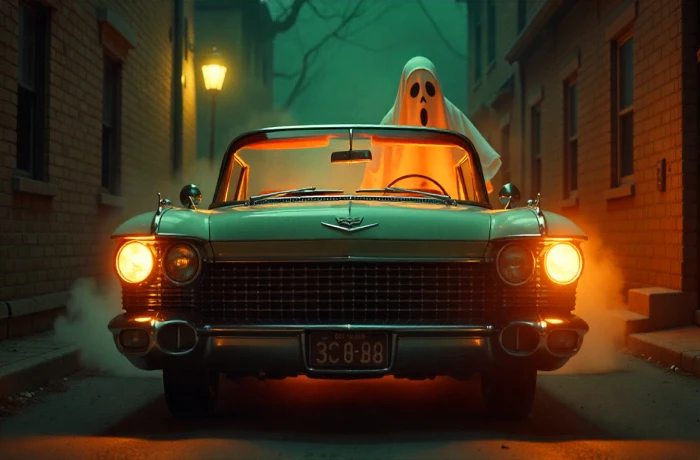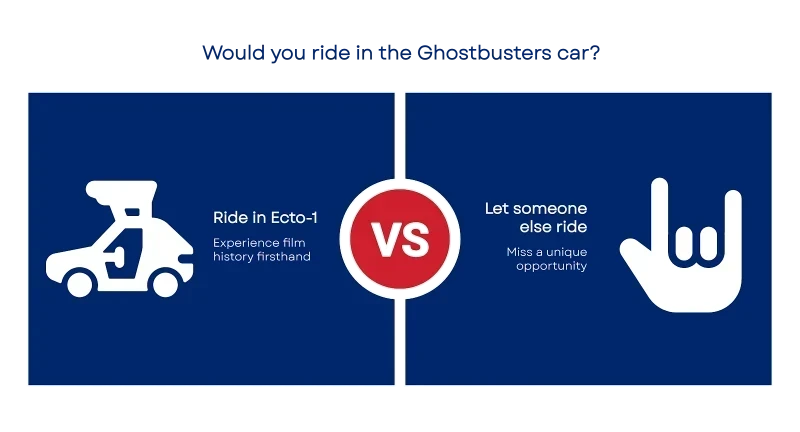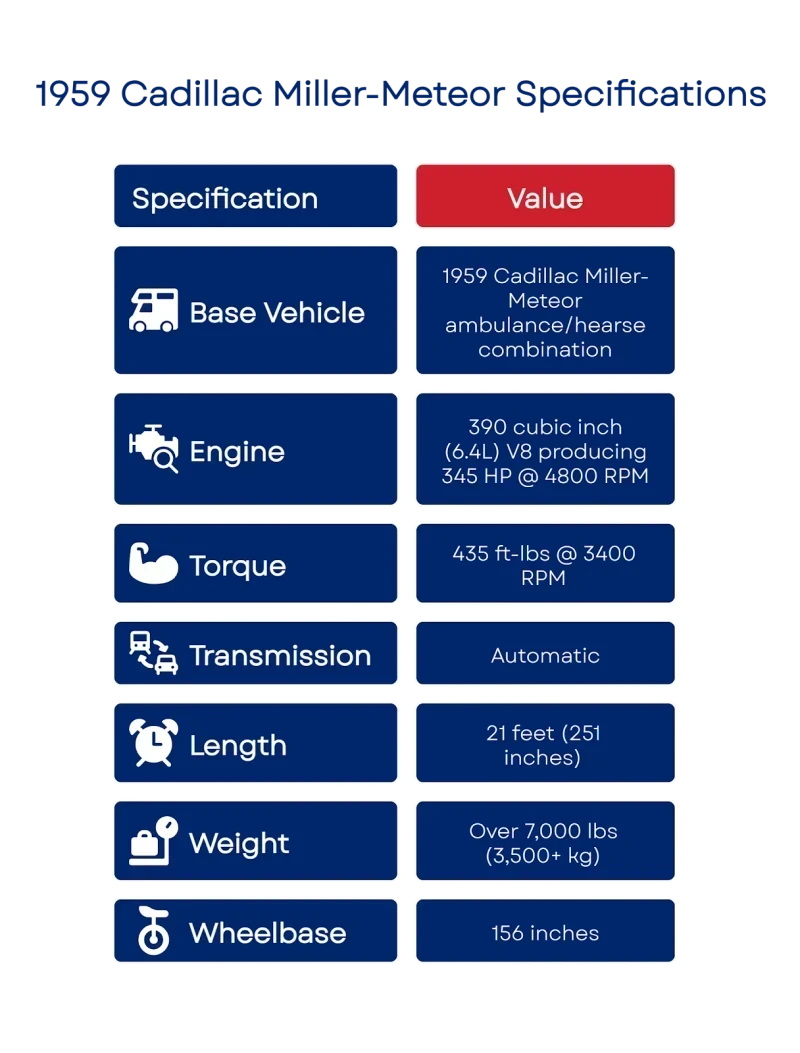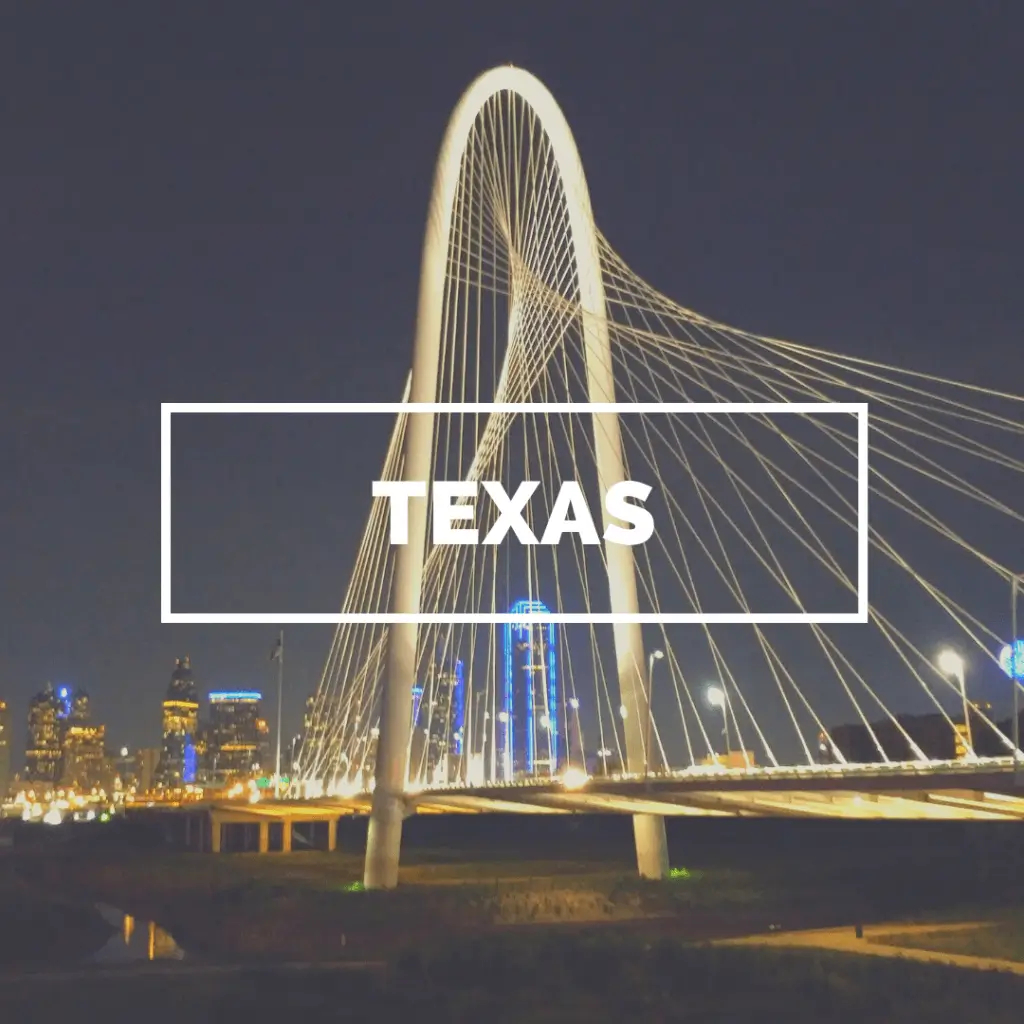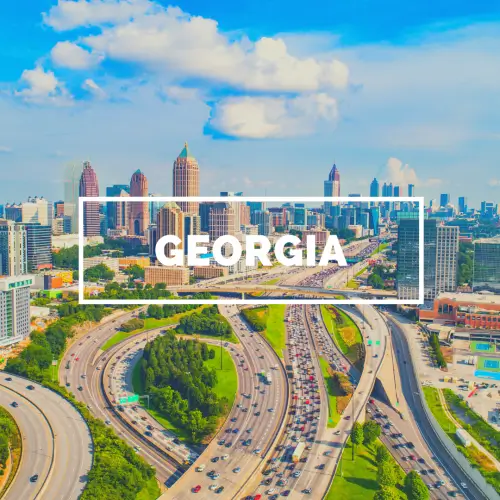What If You Could Ride in the Real Ghostbusters Car?
Imagine sitting inside the real Ghostbusters car from the movies, siren blaring as you grip the wheel. Would you jump at the chance—or let someone else take the seat?
Most people never get close to a movie car, let alone ride in one. The Ecto-1 isn’t just any movie car. It’s part of film history, along with the Cadillac Fleetwood (used in the 2016 reboot). And now, there’s a way for you to experience it for yourself.
What You’ll Learn
In this article, you’ll find out:
How you can ride in the real Ghostbusters car
How the original 1959 Cadillac was turned into a vehicle recognized around the world
Where can you find and book the Ghostbusters car for your event
Summary
The Ecto-1 from the 1984 Ghostbusters film stands as one of cinema's most beloved vehicles. This modified 1959 Cadillac Miller-Meteor combination car transformed from a somber ambulance/hearse into an iconic ghost-busting machine that captured audiences worldwide and became a cultural phenomenon spanning four decades.
The Real Vehicle Behind the Magic
The Ecto-1 wasn’t a custom build—it began as a 1959 Cadillac Miller-Meteor Futura Duplex. This was a professional chassis built by Miller-Meteor, a coachbuilder specializing in ambulances and hearses. The "Duplex" designation meant it could serve as either an ambulance or a hearse, making it perfect for the Ghostbusters' needs.
Technical Specifications:
Base Vehicle: 1959 Cadillac Miller-Meteor ambulance/hearse combination
Engine: 390 cubic inch (6.4L) V8 producing 345 HP @ 4800 RPM
Torque: 435 ft-lbs @ 3400 RPM
Transmission: Automatic
Length: 21 feet (251 inches)
Weight: Over 7,000 lbs (3,500+ kg)
Wheelbase: 156 inches
From Pink Hearse to Ghost-Busting Icon
Despite the film showing it as a rundown hulk, the team actually began with a pristine pink Miller-Meteor in excellent condition. The transformation was extensive and created by hardware consultant Stephen Dane (who was controversially uncredited in the final film).
Movie Modifications:
Paint: Bright white with red Miller-Meteor "Flite-Fin" trim
Emergency Equipment: Multiple light bars, sirens, and beacons
Roof Rack: Mysterious scientific equipment and gadgets
Interior: Modified gurney system for proton pack storage
Logos: Iconic "No Ghost" emblems on the doors
Movie Production Details
The filmmakers used two different vehicles during production:
Primary Ecto-1: Fully modified with all equipment for filming
Backup Vehicle: Used for pre-modification scenes and as a spare
Fun Fact: In the film, Ray Stantz claims he bought the car for $4,800 (equivalent to about $14,500 today). He rattles off repairs like “suspension work, shocks, brakes, steering, transmission, rear end, new rings, mufflers, and a little wiring..."
The Iconic Siren and Sound Design
The Ecto-1's distinctive wail was explicitly custom-created for the movie. The one-of-a-kind siren became so tied to the franchise that it’s instantly recognizable even decades later. The sound wasn't from any real emergency vehicle; it was engineered in post-production to be more dramatic and memorable.
Cultural Impact and Legacy
Immediate Success:
Toy Sales: AMT/Ertl produced popular 1/25 scale model kits
Merchandising: Spawned countless toys, collectibles, and replicas
Recognition: Cemented its place as one of cinema’s most iconic vehicles
Key Components:
Roof Rack Equipment: Mix of authentic lab gear and custom fabrication
Light Bars: Modern LED equivalents of 1980s emergency lights
Interior: Custom gurney system and period-appropriate gauges
Sound System: Replica siren and ghost-detection equipment
The Miller-Meteor Legacy
The original Miller-Meteor company produced only about 400 Futura Duplex models, making authentic donor cars incredibly rare. By the late 1970s, van-based ambulances had replaced these large car-based units, making the Ecto-1's design already nostalgic when the movie was made.
Modern Restorations and Preservation
The original movie cars have been professionally restored multiple times:
Restored by Cinema Vehicle Services for museum displays
Featured at the Petersen Automotive Museum and Universal Studios
Used for promotional appearances and special events
Current Status: The original Ecto-1 remains in the hands of Sony Pictures, occasionally appearing for movie promotions and special events.
From Standard Cadillac to Movie Prop
The Ecto-1 began as a 1959 Cadillac Miller-Meteor. These vehicles were used as ambulances or hearses. The base model had space in the back for stretchers or equipment. It measured over 21 feet long and weighed more than 7,000 pounds.
Before filming began, the car had no markings or add-ons. It was plain and unmodified.
The production team made changes to match the tone of the film. They installed rooftop gear, custom lights, and a new paint scheme. After the updates, the vehicle stood out on screen and in person. It became part of the franchise's identity.
Why People Still Care About the Ghostbusters Car
The Ghostbusters car continues to attract attention more than four decades after the first movie was released. It’s one of the few vehicles in film that became instantly recognizable based on sound, appearance, and purpose. It wasn’t just part of the background. It played a role in the team’s identity.
Fans remember the siren, the roof rack, and the No-Ghost decals. Each detail added to the character of the vehicle. The car became an icon tied directly to the story. Even people who haven’t seen the whole movie recognize the Ecto-1 by its appearance.
Over the years, the car has stayed in circulation through sequels, merchandise, and pop culture references. It’s a reminder of a movie that blended humor, science fiction, and a strong visual identity.
The Vehicle Used for the Ecto-1
The car used in the film was a 1959 Cadillac Miller-Meteor, which combined features of an ambulance and a hearse. True Ghostbusters fans will recognize it as the Ecto-1. It was introduced in the 1984 film when Dr. Ray Stantz purchased and modified it for the team.
Miller-Meteor was a coachbuilder based in Indiana. The company produced a limited number of vehicles each year. The Futura Duplex combined both ambulance and hearse functions into one car. That meant it had a raised roof, rear access, and extra storage space. Those features made it easier for the film crew to add custom equipment without changing the shape of the vehicle.
By the early 1980s, this model was no longer standard. Many had already been retired or scrapped. Vans had started to replace large professional cars like this in ambulance fleets. When the studio sourced the Cadillac, it was already considered outdated, but it had the size and structure they needed.
The car had enough room for camera setups, interior shots, and mounted props. It also had a recognizable profile that worked well on screen. This made it a practical choice for the type of production the film required.
Technical Specs of the Ecto-1
The 1959 Cadillac Miller-Meteor used for the Ecto-1 was built on a full-length commercial chassis. It was designed to handle the weight of medical or mortuary equipment, which made it suitable for carrying the extra props added during production.
The car was powered by a 390 cubic inch V8 engine that produced 345 horsepower. It delivered 435 pound-feet of torque. The transmission was a four-speed automatic, standard for Cadillac models of that year. This setup provided the vehicle with sufficient power to move its weight, but its size made it challenging to maneuver in tight spaces.
The Ecto-1 measured 21 feet in length with a 156-inch wheelbase. It weighed over 7,000 pounds once fully loaded with film gear and mounted parts. Turning and parking required extra space and planning. On set, the crew had to account for its limited mobility when blocking scenes.
The suspension was stock and not designed for fast driving or sharp cornering. Because of its weight and length, the car was better suited for straight, slow driving scenes. For the movie, this worked. The camera shots emphasized arrival, presence, and visibility rather than speed or agility.
How the Car Was Modified for Filming
The Cadillac Miller-Meteor used for the Ecto-1 arrived on set in its original condition. It was faded pink and had not yet been fitted with any equipment. The production team repainted the car white and added red trim along the fins, roofline, and wheel arches. These changes created visual contrast and made the car more noticeable on screen.
A roof rack was installed to hold non-working parts designed to look like custom scientific equipment. These included tanks, tubing, radar-style dishes, and other objects meant to suggest ghost-tracking technology. Each item was chosen for appearance rather than function. The layout was balanced to look intentional without interfering with the car’s basic structure.
Rotating lights and sirens were added to the roof and front grille. The lights were functional and used in driving scenes. The sound for the siren was added during post-production and was not generated by the car itself. The decals on the doors featured the “No-Ghost” logo in red, white, and black. These helped identify the car as part of the Ghostbusters brand throughout the film.
Inside the vehicle, some changes were made to fit large props such as proton packs. Equipment racks were installed, and the rear compartment was cleared to allow quick loading and unloading during scenes. The dashboard and seats remained mostly stock but were cleaned and repaired to match the rest of the modified appearance.
Number of Cars Used
Two Cadillac Miller-Meteor vehicles were used during the production of Ghostbusters. Both were sourced as 1959 models, but each served a different function on set.
The first car remained close to its original condition for early scenes. It was used before the Ecto-1 was introduced as a fully equipped service vehicle in the story. This version of the car appeared with minimal exterior changes and without the roof rack or decals.
The second car received a complete set of visual modifications. This included the new paint, roof equipment, sirens, and lighting. It was used in most of the exterior driving scenes and in any shots where the Ecto-1 needed to be seen in action or parked with the full gear setup.
Using two vehicles helped the production team stay on schedule. One car could be prepped or maintained while the other was used for filming. It also allowed the crew to capture different stages of the car’s appearance in the story without having to redo or reverse any modifications between takes.
Over time, the fully modified car became the version most recognized by viewers. That version was later restored and remains in use for studio events.
The Siren Sound
The siren used for the Ecto-1 was not taken from any real emergency vehicle. It didn’t come from a police cruiser, ambulance, or fire truck. The production team made a deliberate choice to create something original.
They wanted a sound that stood out, one that couldn’t be mistaken for anything else. Sound designers built a custom effect using pitch changes and distortion. It had a rising and falling tone, with no fixed rhythm. That gave it an unnatural, attention-grabbing quality.
The siren was added during editing. It wasn’t part of the live-action footage. While the car had working lights, the siren sound didn’t play on set. This allowed for better control over timing and volume when scenes were put together.
The same siren has been used in every sequel. It also appears in trailers, toys, and video games tied to the franchise. Today, it’s one of the most recognizable audio cues in film.
Merchandising and Fan Builds
The Ecto-1 has been reproduced in many licensed products. Toy companies, model kit manufacturers, and game developers have included the car in their Ghostbusters lines for decades.
Brands like Hot Wheels, LEGO, and AMT have released official versions in multiple sizes. These models range from small collectibles to large, detailed kits with dozens of parts. Some include working lights, moving doors, or scaled proton packs. Retailers continue to restock them due to steady demand.
Beyond licensed merchandise, the Ecto-1 has inspired full-scale builds by fans. These projects often start with other Cadillac professional cars from the same period. Builders add roof racks, decals, and custom lighting to match the on-screen version. Some use original 1959 Miller-Meteor models, though these are hard to find.
Fan-built replicas appear at conventions, charity events, and car shows. Many include working sirens and lights, though some are static displays. Each replica varies in accuracy and function, depending on the base car and parts used.
The continued presence of the Ecto-1 in both licensed products and fan communities keeps it visible long after the original film’s release.
Final Thoughts
The Ghostbusters car is more than just a prop on a movie set. It was selected, modified, and used in a way that gave it lasting visibility. Built from a rare Cadillac platform and customized with simple but effective modifications, it became one of the most iconic vehicles in movie history.
Its continued presence in sequels, fan events, and licensed products shows how well the original design served its purpose. It met the needs of the production while staying memorable to audiences.
For people who work with vehicles, props, or event planning, the Ecto-1 remains a valuable case study. It shows how function, visual clarity, and brand alignment can turn a standard platform into something that lasts far beyond its original use.
Need Help Shipping Your Car?
If you're planning to ship a car, we can help. AmeriFreight Auto Transport arranges vehicle transport through licensed carriers across the country. Whether you're relocating, buying a car, or sending one to a family member, we make the process straightforward.
To get started, contact us. We'll walk you through the steps and help match you with a carrier that fits your timeline and route.
If you’re transporting a collector or show vehicle, visit our classic car shipping services page for more information.
Frequently Asked Questions (FAQs)
What are the main components of the roof of the Ghostbusters car?
The roof of the Ecto-1 features light bars, sirens, beacons, and a prominent roof rack equipped with various props designed to look like ghost-tracking technology, such as tanks, tubing, and radar-style dishes.
How much does a real Ecto-1 replica sell for at auction?
The sale price varies widely based on accuracy, condition, and build quality; there's no standard price. Official screen-used vehicles are scarce and would be much more expensive.
Can you build a Ghostbusters car from a different kind of hearse?
Yes, it's possible to build a replica from other hearses or large professional cars from the same era, especially other late 1950s/early 1960s Cadillacs with similar body styles.
How much does it cost to build a Ghostbusters car replica?
The cost can range from tens of thousands to over a hundred thousand dollars, depending on the desired level of detail and authenticity, including the donor vehicle, custom fabrication, and repairs.
Disclaimer: Please note that this article is for informational purposes only and is not endorsed by, affiliated with, or sponsored by Sony Pictures, Columbia Pictures, or any other entity associated with the Ghostbusters franchise. All trademarks and copyrights belong to their respective owners. While efforts have been made to ensure accuracy, some details may be subject to interpretation or based on widely accepted fan information.


